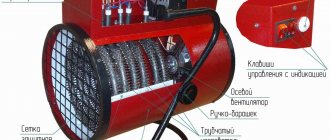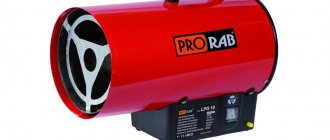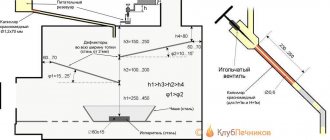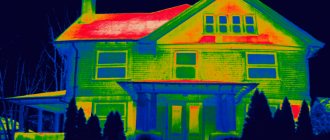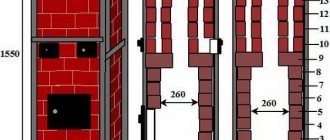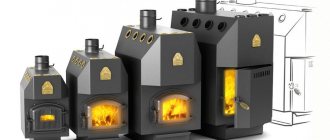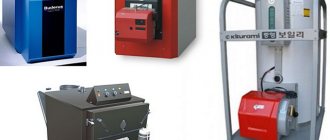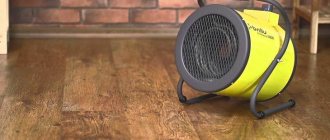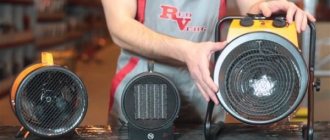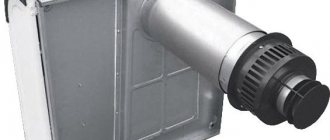Liquid fuel heat guns: types, device
Diesel fuel can be bought, perhaps, everywhere. This explains the high interest in heating units of this kind. But it must be remembered that when burning there is always a smell and fumes. And the cost of heating will be higher when compared, for example, with similar units running on liquefied gas. Therefore, in most cases, a diesel heat gun is purchased as a temporary option - for heating a building under construction, a garage. Such units are convenient for heating warehouses and industrial premises. With good ventilation, direct heating guns can be used. They have an efficiency close to 100%, but combustion products remain in the room. Therefore, well-functioning ventilation is necessary so that the concentration of harmful substances does not exceed permissible limits.
Scope of application of a diesel heat gun
For heating residential buildings, diesel guns are used very rarely. If they are used, then only models with exhaust gas removal. They are also called indirect heating. They have a lower efficiency (80-85%), but combustion products are discharged outside the room. To do this, a chimney pipe is connected to the outlet pipe of the combustion chamber, which is led outside.
Direct heat - high efficiency
The direct heating diesel heating gun has a very simple design. There are two key devices - a fan and a burner. They are built into a metal case. The body most often has the shape of a cylinder and looks very much like a cannon.
Direct heating diesel heat gun device
Fuel is supplied to the nozzle, where it is sprayed and mixed with air. The resulting mixture is set on fire. In well-designed/calculated designs, the flame does not escape beyond the combustion chamber. Only heated air comes out. To increase heating efficiency, there is a fan behind the nozzle that drives air along the combustion chamber.
As can be seen from the design, combustion products enter the room. Therefore, it is very important to use high-quality fuel. One option is kerosene. It has a less unpleasant odor and emits less soot. However, the smell, soot, oxygen burning - all this is present, even if you burn with kerosene.
Indirect heating - with removal of combustion products
A diesel gun with an exhaust outlet differs only in that the combustion chamber is sealed relative to the room. Combustion products are discharged through a pipe in the upper part. A chimney is connected to this pipe, which must be led outside.
How does a diesel fuel heat gun with gas removal (indirect heating) work?
The air driven by the fan flows around the combustion chamber body and heats up. This heats the air in the room. It is clear that this is not nearly as effective as the previous design, but it is much safer. Although ventilation is still needed, since oxygen is still taken from the air. But the exhaust does not remain in the room.
Application
A diesel fuel heat gun can be used in a number of cases:
- The device is used to supply heat to warehouse premises - they generate a large amount of hot air, so they can become an alternative to full heating.
- It can act as a backup heat source for heating various rooms during the cold season.
- It can be used as a heating device on construction sites that do not yet have full heating.
- Heat garages.
- For heating hangars in which equipment is located and people work.
- Can be used for installing suspended ceilings - a powerful heat source is required here.
- To create a warm and comfortable atmosphere in greenhouses.
Diesel heat gun: power selection
The choice of power depends on how you intend to use the unit. If the goal is to maintain the temperature, consider the standard. Usually - 1 kW per 10 square meters of area. If the goal is to quickly raise the temperature “from minus” to a comfortable level, you need to use two to four times more power. The more power you have, the faster you will achieve the desired temperature. Just keep in mind that fuel consumption will be higher, and so will the price of the unit.
Table for selecting the power of a heat gun depending on the area and the required temperature difference
If we take “average” in your case, there is a simple formula that can be used to calculate the required performance more accurately.
Formula for calculating the power of a heat gun
Questions may only arise when determining the thermal conductivity coefficient. In general, this value is calculated based on the material of the walls, ceiling and floor. But the calculation is long and complex. But you can take approximately:
- from 0.6 to 1 with well-insulated walls (according to recommendations for your region);
- from 1.1 to 2 with normal insulation (a brick wall with two bricks without additional insulation is considered 2);
- from 2 to 3 with insufficient insulation (brick in one row is 2.5);
- dilapidated, metal buildings - from 3 and above.
When choosing a coefficient, you must also take into account the degree of insulation of the floor, ceiling, doors and windows. If a lot of heat escapes through them, increase the coefficient. If they are well protected from heat leakage, reduce.
A little bit of history
An interesting fact is that the first fuel injector appeared in the second half of the 19th century thanks to the Russian engineer A.I. Shpakovsky. The system had a number of shortcomings, so it was not widely used.
14 years later, V.G. Shukhov, while still a student at Moscow Higher Technical University, invented a nozzle designed for burning fuel oil. With this discovery, diesel-powered equipment began to be used everywhere. It is this nozzle that is still used today. True, it has undergone a number of modernizations.
Other selection options
Although a diesel heat gun is not the most aesthetically pleasing heating device, it must be safe - there are no options. Therefore, it is worth paying attention to the thermal insulation of the outer casing. To prevent accidental contact from causing a severe burn, the housing should not heat above 50-60°C. The combustion temperature of diesel fuel reaches hundreds of degrees, so thermal insulation is very important.
A diesel heat gun with an exhaust outlet requires the installation of a full chimney
Performance characteristics
In addition to thermal power, there are a number of characteristics that determine the efficiency of equipment:
- Supply voltage and electrical power consumption. There is a fan in the design and it requires power supply.
- Maximum air exchange (cubic meters per hour). Shows how much air is “driven” through the unit. Determined by the power of the fan and burner.
- Fuel tank volume and fuel consumption. These two parameters should be considered together. By dividing the tank volume by the flow rate, you will find out how many hours the unit will operate on one fill.
- Availability of air and fuel filters, regularity of their maintenance. These filters are installed, perhaps, in any more or less normal model. But the filters are different and require different cleaning or replacement intervals. Before purchasing, do not be lazy to read the instruction manual. Some filters need to be cleaned after 150 hours of operation, others after 500. So there is a difference.
- Noise level. An important parameter if it will be used for a long time in a room where people work.
Main functional parts
The fuel consumption of diesel guns is respectable. To reduce it, you can install a thermostat. This will help you save about 25%. If the consumption is still too high, it can be reduced by adjusting the fuel supply. If you make the flow rate less, the warm-up speed may decrease slightly, but not catastrophically. But fuel consumption will be reduced. Using tests, you can select the optimal operating mode.
Security
Some safety features are found in almost all diesel heat guns, while others are added only to some models. As the degree of protection increases, the cost also increases, but saving on security is more expensive.
- Flame control system. It can be implemented in different ways, but the result is the same: if there is no flame, the fuel supply is shut off.
- Shutting off the fuel supply in the event of a power failure. Whether the device turns on automatically after electricity appears or not depends on the model. Needs to be clarified.
- Overheat control. The temperature in the combustion chamber is controlled. If it exceeds the permissible level (set at production), the fuel supply is cut off.
Every normal diesel heat gun has these protective features. This is the base that provides the minimum level of security. In more “sophisticated” versions, an oxygen level sensor and carbon monoxide level control can be built-in. If the selected model does not have atmosphere analyzers, they can be installed separately.
Technical characteristics of some models of Ballu diesel heat guns in the BHDP line
Ease of use
Agree, it is better if the heating unit causes a minimum of inconvenience and requires a minimum of attention. The most important thing is the type of management. The most convenient and modern is electronic control. It has great capabilities both in terms of security and service functions. But models with this type of control are the most expensive. A diesel heat gun can also have:
- Thermostat or thermostat. The device built into the housing allows you to set the desired air temperature. This allows you to pay less attention to monitoring work. When the selected temperature is reached, the unit turns off. When the air cools by one degree, the heating turns on again. The thermostat can be mechanical or electronic.
Technical characteristics of Quatro liquid fuel heat guns - QE line - with direct heating - Monitoring the fuel level in the tank. Helps not to be left without heat and to control the amount of fuel poured when refueling.
- Wheels for moving.
- Adjustable tilt angle.
Not all functions are expensive. For example, wheels and tilt control. They are implemented more than simply, however, their presence facilitates the use of diesel heat guns.
Advantages and disadvantages
Diesel heat gun AURORA DIESEL HEAT 50
Diesel heat guns are widely popular. This is due to the many positive aspects highlighted during the operation of these heating units. Let's note the main advantages:
- Small in size.
- Easy to use and maintain, in order to start the device mechanism, just press a button.
- The devices are highly economical. The amount of fuel consumed depends on the power of the heat gun. For example, with an air flow of 550 m³/hour, approximately 1.5 liters of fuel are consumed, and the power will be 20 kW. This amount of fuel will be enough to heat the garage.
- Capable of heating a room in the shortest possible time.
- They are safe to use. If the gun is installed in a room with good ventilation, then there will be no negative consequences in the form of a burning smell. It is also worth noting that if you touch the device while it is operating, there is no risk of burns, since the body heats up to a temperature of 30-35°C.
- Another important feature of a heat gun is that it can work for a long time without refueling.
Despite the considerable number of advantages of heat guns, such devices also have disadvantages:
- The operation of the devices is accompanied by noise.
- Heat guns are energy dependent; the device cannot function without electrical energy.
- If the appliance is operated continuously for a long time, you may smell diesel fuel.
- Since diesel heaters are mainly intended for heating industrial premises, the cost of such devices is high.
Principle of operation
The principle of operation is no different from heat guns operating on another type of fuel - gas or electricity. It contains a fan that provides air flow to the heating element. After the air warms up, it flows back into the room using the same fan. Uniform distribution allows you to warm up fairly large areas, which is also facilitated by power, air exchange and adjustment of these parameters. Diesel heat guns come in direct and indirect heating.
Sources
- https://yanashla.com/luchshie-dizelnye-teplovye-pushki-nepryamogo-nagreva/
- https://tehno-gid.net/power/top-dizelnyh-teplovyh-pushek-nepryamogo-nagreva-kak-vybrat-ustrojstvo.html
- https://ewme.ru/dizelnye-teplovye-pushki-top-luchshih/
[collapse]
comparison table
The table shows the main performance characteristics and cost of each diesel gun, so that all users can find the best option for themselves.
ModelPower, kWMaximum air exchange, m³/hourFuel consumption, l/hTank capacity, lAverage price, rub.
| BISON DPN-K9-21000-D | 21 | 1000 | 2,04 | 55,5 | 32 500 |
| NeoClima NPI-20 | 7,56 | 49 | 30 000 | ||
| Ballu BHDN-20 | 20 | 500 | 1,92 | 24 | 36 500 |
| ELITECH TP 30DN | 30 | 700 | 2,9 | 49 | 45 500 |
| Aurora TK-55 ID | 17,5 | 380 | 1,7 | 40 | 42 500 |
| Master BV 77 E | 20 | 1550 | 2 | 36 | 60 000 |
| RESANTA TDPN-30000 | 30 | 800 | 2,88 | 56 | 52 000 |
Terms of use
Before putting the gun into operating mode, you need to make sure that the rules are followed to make its operation safe. Below are recommendations that will help extend the life of the device.
Operating rules:
- To place the device, you need to choose a flat, stable surface made of non-flammable materials. A concrete or metal floor will do.
- It is important to maintain the distance from the nozzle to objects located next to it. Minimum – 2 m. Leave a passage of at least 1 m on the sides.
- Before using the device for the first time or turning it on after it has been inactive for a long time, you need to develop the fan impeller by hand. It should rotate freely.
- To refuel the device, it is disconnected from the network.
- After switching off, do not immediately unplug the plug from the socket. You must wait until the fan stops completely. This takes about five minutes.
Characteristics
To understand which device is better to buy, you need to carefully read its characteristics. The functionality of the equipment is one of the most important selection criteria. The popularity of models is also influenced by cost, power, and equipment.
| Characteristic | Description |
| Air heating type | Direct, indirect. |
| Heating source | Diesel. May be gas or electricity. |
| Dimensions | Specify the width, height and depth of the model. |
| Power | The power of small indirectly heated guns is 20-85 kW. There are industrial high-performance devices in which this figure can reach 220 kW. |
| Ventilation | Measured in m3/h. For example, for Master brand models it varies from 1,550 to 3,300 m3/h. For industrial ones - 4,400-12,500 m3/h. |
| Cannon shape | Rectangular devices have a larger area for inflating heated air. |
| Mobility | A device on wheels is more convenient to use than a stationary one. |
| Power and temperature adjustment | Devices with power control are equipped with a knob that programs the thermostat settings. |
| Heating speed | How long will it take for the gun to heat the room? |
| Fuel consumption | Heat guns for industrial areas have the highest fuel consumption. This is directly related to greater productivity. |
| Room area size | The area of the room that the device can heat is often indicated. |
| Weight | The design of the device and the material of the housing influences. |
| Guarantee | The specifications always indicate the period during which the user can apply for a free replacement of the device if it breaks down. |
| Manufacturer country | The country in which the device was released. |
| Equipment | Listed are the additional accessories that come with the kit. For example, hoses and nozzles. There may be a room thermostat. |
| Price | The devices are inexpensive (up to 25,000 rubles) and heat small rooms. Industrial guns with high power are produced for production areas, which cover an area exceeding a thousand m2. Their cost is many times higher than those with lower performance. |
